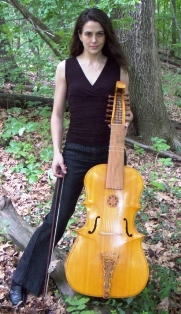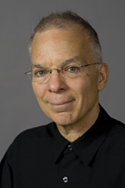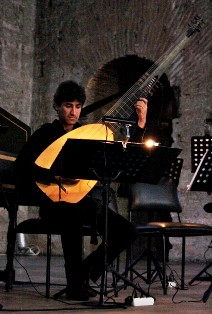
Quadricentennial at Christ Church

Annalisa Pappano with her lirone
|
Rivers, director of choral studies and head of the division of ensembles and conducting at CCM, will span the years at 5 p.m. Sunday evening in Christ Church Cathedral downtown by conducting Claudio Monteverdi's monumental "Vespro della Beata Vergine" of 1610 ("Vespers of the Blessed Virgin").

Earl Rivers
|
Rivers has led the Vespers several times in Cincinnati, but not quite on the quadricentennial scale he is giving it this time. Participating in the anniversary concert are the CCM Chamber Choir, CCM Chamber Orchestra, eight vocal soloists and a “continuo” group of eight musicians performing instruments of the period.
An invention of the early Baroque period, “continuo” refers to the accompaniment provided by those musicians who perform the bass line throughout a work and the harmonies specified to go with it (by a special system of notation called "figured bass"). The continuo can be a keyboard (harpsichord, organ) and a bass instrument like the double bass, but it can be much more elaborate. Forming the continuo in the Vespers is a cadre of Early Music specialists on harpsichord, organ, viola da gamba, lirone, theorbo, archlute, baroque guitar, harp and double bass.

Michael Leopold playing the theorbo
|
What makes the 1610 Vespers a landmark is the wealth of styles and invention it contains. Harpsichordist Vivian Montgomery, who commutes from Boston to Cincinnati to teach at CCM where she is a member of the adjunct faculty, describes it as “a real tour of Monteverdi’s everything. It has virtuosic instrumental music in addition to some gorgeous vocal solos and really substantial choral movements.”
“In his
Vespers," said Rivers, "Monteverdi retains traditional compositional elements, such as chant
and Renaissance polyphony, and he introduces the newest styles of music that
had only recently been invented.”
The 90-minute work comprises psalms, motets, a sonata, a hymn and a Magnificat, 13 parts in all, arranged according to the Roman Catholic service of Vespers. Composed for Monteverdi’s employer, the Duke of Mantua, it has puzzled scholars literally for centuries as to why it was written the way it was, i.e. with so many kinds of music, and for what purpose. One theory is that it was a kind of “audition” piece which Monteverdi hoped would earn him the plum job of maestro di cappella at St. Mark’s Basilica in Venice (which he did, in fact, win three years later).
One reason Rivers is so excited about his 2010 Vespers is the opportunity it has given him to bring together some of the best Early Music talent. In addition to Leopold and Montgomery, participants include nationally known viola da gambist/lironist Annalisa Pappano, who sparked the Early Music movement in Cincinnati by founding Catacoustic Consort in 2000, and Rodney Stucky, who will play archlute and Baroque guitar. Stucky and Pappano are co-directors of CCM's Early Music Lab. Rounding out the continuo group will be CCM students Micah Fusselman (viola da gamba), Sujin Kim (organ) and Kyle Elkins (double bass).
To add even more color to the mix, Rivers has invited a pair of cornettists (looks like a recorder, sounds like a trumpet) to join the student orchestra, Kiri Tollaksen and Shawn Spicer. Tollaksen of Ann Arbor, Michigan, performed with Catacoustic Consort on a Christmas program last December at Northside Presbyterian Church.
Vocal soloists are sopranos Kelly Ballou and Abigail Santos, mezzo-soprano Ivy Walz, tenors Andrew Penning, Ryan C. Connelly and Ian Ramirez, baritone Thomas Richards and bass Timothy Bruno.
Admission to the concert is free. The musicians will introduce their instruments at a brief “show and tell,” beginning at 4:45.
A Vespers Bestiary.
Viola da gamba: Since the
1991 film “Tous les matins du monde” (“All the Mornings of the World”) about 17th-century
viola da gambist Marin Marais (played by Gerard Depardieu), there has been a spike of interest in Early Music, said Pappano. The instrument itself has begun to recover
some of the popularity it enjoyed centuries ago, when people kept “consorts” of
viols in their homes for performance by family members.
Lirone: Pappano distinguished the viola da gamba and the
lirone: “They are separate families of instruments. The viola da gamba (“leg viol,” meaning held between
the legs) has six strings and is more melodic.
It kind of looks like a cello, but is fretted and played with an
underhand bow grip.” Viols come in
different sizes (Pappano specializes in the treble viol and related pardessus viol.) Fusselman will play bass viola da gamba in the Vespers. Pappano will play lirone.
“”The lirone is a chordal instrument that reinforces harmony,” she said. “My instrument has 12 strings and a super-flat bridge, so I have to play chords. I have to play more than one string at once. To my ear, it sounds kind of like the right hand of an organ in a really high register. So while Micah is playing just the bass line, the left hand of the organ, I’m playing the right hand.”
Theorbo: The theorbo is a bass lute, Leopold explained. Despite its length (5 to 6 1/2 feet), it is light, “just a couple of pounds,” he said. “The wood is very thin.” The theorbo was very popular instrument during the Baroque period, and was used a great deal for opera performances. Leopold (originally from California) performs regularly with opera companies in Europe and the U.S., including Houston Grand Opera and Chicago Lyric Opera. He has been in Cincinnati previously to play with Catacoustic Consort.
The origin of the word “theorbo” is a mystery, Leopold said. “There’s all kinds of speculation.” (The related instrument in Ukraine is called a “torba," deriving from the Turkish/Slavic word for bag.)
Archlute: Stucky, who performs as a duo with his wife, soprano Mary Henderson Stucky, and with the Cincinnati Early Music ensemble Apollo’s Cabinet, came to the lute when a classmate asked him to accompany her on her senior recital. “She wanted to do some lute songs. I didn’t know what that was, so I took the music, and the first piece I started to read through was John Dowland’s ‘Flow My Tears.’ I was smitten. I thought this was the most gorgeous piece of music I had ever heard in my life. I couldn’t put it down.”
Lutes came in different sizes, Stucky said. “There were bass lutes, tenor lutes, alto lutes. Around 1600, they started experimenting with them. They used lutes for accompaniment and wanted to expand the bass range.” That meant either fattening the strings or lengthening them, he said. “Fatter strings tend to sound kind of tubby, so they decided to extend the string length.” The bass lute, or archlute, which he will play on the concert, has two peg boxes, one for the shorter strings and one for the longer (bass) strings. “You get this unique sound. It goes very low, but because of the length of the strings, it has a real bite to it.”
Baroque guitar: The Baroque guitar, which Stucky will also play, is smaller than the modern guitar. “The string length is about the same, but the body is small. It is much more slender and instead of six single strings, it has five pairs of strings and is much lighter, maybe not even half as heavy as the modern guitar. It has a more delicate sound that cuts quite well.”
Harpsichord, harp: Montgomery will play the same reproduction 17th-century harpsichord built by Douglas Sutherland of Ann Arbor that she played on concert:nova's recent Baroque festival at the Cincinnati Art Museum. She and Sujin Kim will share a small, continuo organ from CCM. Harpist Motter recently acquired a Baroque harp, but because of the short preparation time before the concert, will play a modern instrument.
Cornetto: Obsolete after the turn of the 19th century, except for the occasional wind or town band, the cornetto it looks like a bent recorder, but sounds like a trumpet. Considered a member of the brass family, it is made of hardwood covered with leather, has finger holes like a woodwind and a trumpet-shaped mouthpiece made of animal horn.The concert is sponsored by CCM's Tangeman Sacred Music Center.